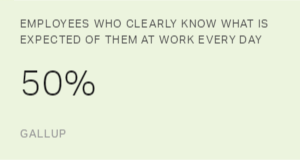Story Highlights
- Improve business performance through improved employee engagement
- Measuring employee engagement is the first step to increasing it
- Successful employee engagement initiatives measure specific elements
It's great when companies try to improve employee engagement and even better when they measure it. Measurement is the first step companies must take before they can implement meaningful actions to improve engagement. But if they don't measure the right things in the right way, those actions won't matter -- and they won't have a measurable impact on business outcomes or the bottom line.
The narrow focus used in tools like employer net promoter score (eNPS) don’t reveal the full picture of the state of your workforce or point to opportunities to potentially improve business outcomes.
Concentrating on employee engagement can help companies withstand, and possibly even thrive, in tough economic times.
"Measurement is one thing, what you measure is another," says Jim Harter, Ph.D., Gallup's chief scientist of employee engagement and wellbeing. "You can measure a lot of things that have nothing to do with performance and that don't help a company implement a system that allows managers to create change."
Gallup's Q12 employee engagement assessment is designed to uncover the things that really matter to employee engagement and business performance. It's backed by rigorous science linking it to 11 integral performance outcomes. And Gallup researchers continually study research findings on the Q12 to learn more about employee engagement and its impact on organizational and team performance.
Predicting Key Performance Outcomes
Every two to four years, Gallup completes meta-analysis research -- a statistical technique that pools multiple studies -- on the Q12. By conducting this research regularly over time and increasing the number of work units analyzed, Gallup stays on the cutting edge of how well employee engagement predicts key performance outcomes.
In 2020, Gallup conducted its 10th meta-analysis on the Q12 using 456 research studies across 276 organizations in 54 industries and 96 countries. Within each study, Gallup researchers statistically calculated the work-unit-level relationship between employee engagement and performance outcomes that the organization supplied. Researchers studied 112,312 work units, including 2.7 million employees. This 10th iteration of the meta-analysis further confirmed the well-established connection between employee engagement and 11 performance outcomes:
- customer loyalty/engagement
- profitability
- productivity
- turnover (for high-turnover and low-turnover organizations)
- safety incidents
- shrinkage (theft)
- absenteeism
- patient safety incidents
- quality (defects)
- wellbeing (net thriving employees)
- organizational citizenship (participation)
When Gallup researchers analyzed the differences in performance among business work units, the benefits of employee engagement were clear. When comparing employee engagement levels, Gallup found that top- and bottom-quartile business units and teams had the following differences in business outcomes*:
- 81% in absenteeism
- 58% in patient safety incidents (mortality and falls)
- 18% in turnover for high-turnover organizations
- 43% in turnover for low-turnover organizations
- 28% in shrinkage (theft)
- 64% in safety incidents (accidents)
- 41% in quality (defects)
- 10% in customer loyalty/engagement
- 18% in productivity (sales)
- 23% in profitability
These kinds of performance differences are always important to businesses, but they are especially crucial during a disruption, when an organization’s ability to positively affect employee engagement and wellbeing to continue driving growth and productivity is of critical importance. Generally speaking, employee engagement and wellbeing are reciprocal and additive, but amid the disruption of 2020, Gallup researchers saw the two diverge.
Another timely benefit of employee engagement in times of uncertainty is that high engagement boosts retention. Employees who are actively engaged are less likely to be actively looking or open to a new job opportunity. In fact, low engagement teams typically endure turnover rates that are 18% to 43% higher than highly engaged teams.
The 2020 meta-analysis verified once again that employee engagement relates to each of the 11 performance outcomes studied. Gallup also finds that the strong correlations between engagement and performance are highly consistent across different organizations from diverse industries and regions of the world.
Increased Engagement Leads to Higher Earnings Per Share
Gallup's research has also shown that companies with engaged workforces have higher earnings per share (EPS), and they seem to have recovered from the 2008 recession at a faster rate. In an older study, Gallup examined 49 publicly traded companies with EPS data available from 2008-2012 and Q12 data available from 2010 and/or 2011 in its database. This study found that businesses with a critical mass of engaged employees outperformed their competition.
Researchers discovered that as the economy began to rebound after 2009, having an engaged workforce became a strong differentiator in EPS. Companies with engaged workforces seemed to have an advantage in regaining and growing EPS at a faster rate than their industry equivalents. Conversely, companies with average engagement levels saw no increased advantage over their competitors in the economic recovery.
Measuring What Matters
Joseph Juran, noted management expert, said, "Without a standard, there is no logical basis for making a decision or taking action." Most companies understand this to some degree, but many persist in measuring performance by the wrong standard -- using unsubstantiated or ineffective metrics that ultimately lead nowhere. When leaders work with Gallup to measure and manage employee engagement at their companies, they can be confident that the Q12 is backed by years of empirical research.
Factors such as EPS, profitability, productivity, and customer ratings are all key indicators in determining a company's health and its potential for growth. The research shows that the Q12 is a business' best measurement tool for initiating companywide transformation to create sustainable growth.
"Companies constantly evolve, and they need new ideas all the time. Engaged employees are a lot closer to the best ideas," says Jim Harter. "They're thinking about the whole company and how they fit into it, and their ideas lead to better decisions."
By intentionally focusing on measuring and managing employee engagement using Gallup's Q12 metric, companies can gain a competitive advantage that will keep them moving forward. Research shows that concentrating on employee engagement can help companies withstand -- and possibly even thrive -- in tough economic times.
Discover what measuring what matters could do for your organization:
- Learn more about the benefits of employee engagement.
- Increase business performance through employee engagement initiatives.
- Start measuring your employees’ engagement with our science-backed questions.
To learn how Gallup's analytics and tools can help you transform your workplace, visit my.gallup.com.
Susan Sorenson contributed to this article.


